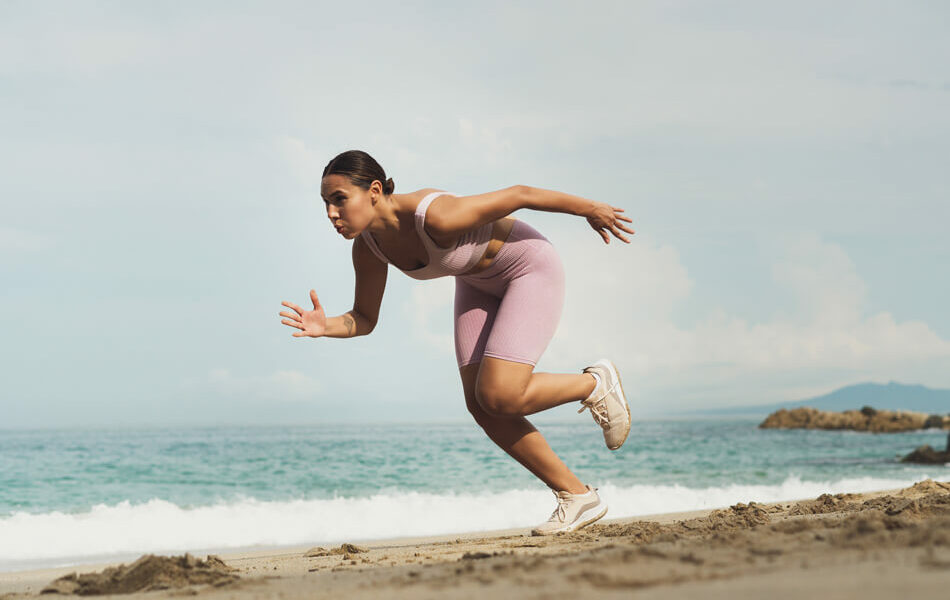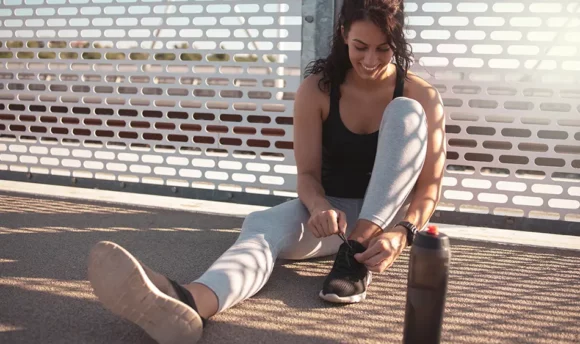Swimming vs. Running: Which Is Better for Burning Calories?
Swimming and running can both help you burn calories; however, depending on your priorities, one may seem more appealing to you. Let’s delve deeper into what value both exercises have to offer.

When choosing what workout to go for, you need to consider how they’ll affect your primary goals and if it’s worth the stress.
The big question is, what are you trying to achieve? Do you intend to burn calories? Tone your lower body muscles? Improve your fitness level? Improve your cardiovascular health? Depending on your answer, choosing between swimming and running becomes easy.
In today’s post, we’ll discuss everything you need to know about both workouts, including their benefits, calorie burn, and disadvantages. So, if you are still uncertain about going for a run or getting prepped for swimming laps, then keep reading.
Swimming vs. Running: Which Is Better?
Swimming and running both have mental and physical benefits, and deciding which is better ultimately boils down to you.
Running is a weight-bearing exercise that improves your bone health, helps you burn calories, and strengthens your muscle groups.
Swimming is considered a low-impact workout that helps in building muscles while putting less stress on your joints.
5 Benefits of Running
Running is easy, but you need to be certain that you are starting your running program with the right equipment, such as a good pair of running shoes.
That being said, running offers a lot of physical and health benefits that’ll make you want to log in some miles every day, including increasing your stamina and endurance.
#1 It helps you sleep better
Having quality sleep is important for your mental health as well. Experts believe that when you exercise regularly, you have a high chance of sleeping better because you are exhausted.
The more you exercise, the more you’ll need quality sleep, so if you’re battling insomnia, you might want to take up running as a workout.
#2 Running helps you burn calories
Running is categorized as a full-body workout because it involves you moving your entire body, meaning it’s a great exercise to lose weight. With running, you can run at a moderate pace and still lose weight, although you might burn fewer calories.
The main issue with weight loss is keeping the extra body fat off. So, when you commit to a consistent running regime, you can do that successfully.
Running is an aerobic exercise that can help you lose significant belly fat without having to make drastic changes in your diet.
#3 Running improves your heart health
Running strengthens your heart while eliminating the risk of cardiovascular diseases. Because running is an aerobic exercise, it can also help reduce high blood pressure.
For optimal cardiovascular health, it’s recommended to engage in a high-intensity workout for 75 minutes per week, and running is perfect for this. Running helps boost your heart rate, and a stronger heart will pump more blood.
#4 Running helps reduce your risk of other diseases
Running can improve your overall health while increasing your lifespan in the process and can even lower your risk of diabetes and other respiratory diseases.
When left unattended, high blood pressure can result in other complicated health issues, but that can be treated with running. However, you shouldn’t ditch your medication without getting approval from your doctor.
#5 Running can help strengthen your entire musculoskeletal system
Running is a weight-bearing exercise that can increase your bone density and help you maintain it, even as you age. The human body will always be in use, and increasing your peak bone density is one sure way to ensure you live a healthy life.
Running involves your lower body muscles; however, your upper body muscle groups also play an important role. So, while running, you strengthen your musculoskeletal system and build your bone strength.
6 Benefits of swimming
Having swimming skills is essential for everyone, regardless of age. It’s a great way to keep fit and stay in shape; swimming is a low-impact exercise with many health and mental benefits.
#1 Swimming builds your cardiovascular strength
Swimming is a cardiovascular exercise that is beneficial to your heart health and lungs. With swimming, you can go at your own pace, do a freestyle stroke, and enjoy the same benefits.
People who swim regularly have a lower risk of developing cardiovascular diseases.
#2 It’s a low-impact workout
Swimming is a low-impact exercise that can speed up your heart rate without causing joint pain. Swimmers often experience the counter effect of gravity against water, meaning it doesn’t put so much pressure on your joints.
Swimming lessons are great for people who have joint pain or osteoarthritis. Swimming offers cardiovascular benefits and can even help prevent heart diseases by battling the fatty compounds that might cause your health to decline.
#3 Full-body workout
Swimming works all your body muscles, so regardless of your chosen swimming style, you’ll get a full-body workout. If you intend to go for a taxing swim style that’ll put enough pressure on your muscles, the swimming butterfly is your best bet.
When swimming, you’re combating water pressure, meaning you’re working harder than you would if you exercised on land. Swimming increases your heart rate, tones your muscles, and helps enhance your fitness level.
#4 It helps burn calories
If you are looking for a cardiovascular workout that burns calories at a fast rate, then you need to consider swimming. For every stroke and body movement, more calories are burned.
In swimming, the amount of calories you’ll burn depends on your body weight and the level of intensity. High-intensity swimming equals high-calorie burn. You can burn an average of 250 calories in a 30-minute swim.
#5 Swimming helps build strength
Studies have shown that swimming is a full-body exercise that can increase your endurance, flexibility, and strength. Being a couch potato is a recipe for weak bones and muscles; 30 minutes of swimming thrice a week is enough to increase your energy levels.
Swimming boosts your functionality in water, leading to an increase in core strength and stability.
#6 Swimming helps to de-stress
Swimming frequently can help lower your stress level and reduce anxiety and depression. One amazing benefit of swimming is that it helps you sleep better. You don’t need to practice high-intensity swimming before you can reap the mental perks.
Swimming can reduce your overall tension and stabilize your mood.
Endurance workouts like swimming stimulate the release of endorphins into the brain, giving you an elevated feeling of happiness and “high.”
Calorie-Burning Comparison
When it comes to swimming vs. running, the calories burned depend on several factors like your body weight and intensity.
On average, a 30-minute swim burns around 250 calories. If you aren’t a fan of the gym and intend to lose more weight, you can choose swimming.
Depending on your intensity, your calorie burn while running for 30 minutes is 200–400 calories, making it a fantastic exercise for weight loss.
Over a short period, swimming burns more calories than running. For example, if you swim the same distance as running, you’ll burn more calories swimming.
So, if you plan on burning as many calories as possible in the long run, you can opt for running unless you’re an Olympic swimmer who enjoys taking a swim.
For those who are very conscious about burning calories while running, the Joggo app is everything you’ll need. It includes personalized meal plans and workout training, and you’ll even have access to a professional consultant who can help with any challenges you might be having.
Muscle Gain Comparison
Swimming is “clear” when it comes to building muscles, and that’s because you’re pushing against the resistance of water. This usually involves different muscle groups, and when you apply much stress to them, there’ll be tiny tears in the muscles.
When the tears heal, it results in muscle growth and increased strength.
Whenever a stimulus is placed on your muscles, it reacts, and that’s the case with running. If you run at a high intensity, your body will automatically try to adapt so it can run better next time.
Running helps with muscle growth by inhibiting the proteins that prevent muscle growth; however, you need to couple this with enough rest and the right diet.
Heart Health
When it comes to heart health, the swimming vs. running comparison is a close one because they both provide enviable heart health.
However, a swimmer has a lower heart rate than a runner. On average, both swimmers and runners have great heart health, with an average resting heart rate of 56bpm and 49bpm, respectively.
Toning Muscles
Swimming is a full-body exercise that involves a lot of muscles when done correctly, but running focuses on just your lower body.
Swimming is the perfect way to increase your body’s muscle mass without being at risk of developing back injury.
Budget Comparison
You don’t need to spend a fortune to kickstart your swimming lessons. All you need is a venue with a nice pool and your swimming goggles, and you’re good to go. However, getting access to a suitable pool might not be feasible depending on your location, and you’ll most likely need to pay.
But with running, a good pair of shoes will suffice. Running costs nothing, and you don’t need a gym because you can run anywhere.
Runner’s Body vs. Swimmer’s Body
Swimming is a high-intensity workout, and most swimmers have a higher percentage of body mass, whereas runners have a low percentage of body fat. Swimmers have a more balanced physique because they use their arms and legs to push past the resistance in the water.
Generally, runners tend to have larger leg muscles and long legs, while swimmers usually have longer arms, defined torso, and broad shoulders.
FAQs
Swimming is a good cardio workout due to the water resistance you need to combat. It takes a huge effort to swim amidst the pressure of water, which can help boost your cardiovascular strength.
If you plan to lose weight through exercise, then you need to maintain a certain speed and cardiovascular exertion. Your calorie burn while swimming for 30 minutes is 250 calories, while for running, you’ll burn about 200–400 calories in a 30-minute run.
Pool walking is a beneficial exercise that can help improve your fitness level and cardiovascular health. If you have stability and balance issues, you might want to consider walking in a pool for 15–30 minutes.
Yes, swimming is a harder workout than running. Swimming requires skill and effort to push against the resistance, or you’ll drown. However, with running, you can just pick up your shoes and go for a quick run, or you can do a quick run on your treadmill.
Swimming is a faster way to lose belly fat. Swimming with the intention of losing belly fat requires more speed and distance. You can’t spend the same amount of time on an aerobic workout if you intend to lose belly fat through swimming. Increase your laps, speed, and the power you put into your swimming training.
A Word From Our Coach
Choosing between swimming vs. running all boils down to you and what you intend to achieve. The most important thing is that you get to merge your choice with healthy eating and sleeping habits.
So, whether you decide to swim or run, keep track of your body’s progress; plus, you can always alternate both workouts. No rule says you can’t have the best of both worlds.
Conclusion
Swimming and running are both great exercises that can help boost your fitness level, increase your strength, and help you lose excess fat.
All you need to do is choose what works for you and pursue it diligently. Also, do not forget to check with your doctor to be sure you don’t have any underlying condition that might worsen due to either exercise.

















































 Select your language:
Select your language: 








